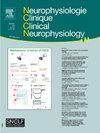Is the decrement pattern in myasthenia gravis due to muscle-specific kinase antibodies different to that due to acetylcholine receptor antibodies?
IF 2.4
4区 医学
Q2 CLINICAL NEUROLOGY
Neurophysiologie Clinique/Clinical Neurophysiology
Pub Date : 2025-07-31
DOI:10.1016/j.neucli.2025.103092
引用次数: 0
Abstract
Objective
A decrement on repetitive nerve stimulation (RNS) is essential for the diagnosis of myasthenia gravis (MG). The decrement pattern is typically “U-shaped” in MG caused by acetylcholine receptor antibodies (AChR-MG) but is less well described in MG caused by muscle-specific kinase antibodies (MuSK-MG). The aim of this study was to investigate RNS abnormalities in MuSK-MG, and to describe the differences in the decrement pattern as compared to AChR-MG.
Methods
This retrospective case-control study included patients diagnosed with generalized MuSK-MG, compared to a control group of generalized AChR-MG. The five most frequently explored nerve-muscle pairs in RNS were analyzed: radial-anconeus, fibular nerve–tibialis anterior (TA), XI-trapezius, XII/V-submental complex (SMC), and VII-orbicularis oculi (OO). Decreased amplitude between the 1st and 4th responses (early decrement) and the late/early ratio were calculated (late/early ratio <100 %=U-shaped pattern, and ≥100 %=progressive pattern).
Results
For MuSK-MG, 25 patients were included and compared to 35 AChR-MG patients. An early decrement was present in 38/83 (54.2 %) muscles in MuSK-MG compared to 88/130 (67.7 %) muscles in AChR-MG; and in MuSK-MG was less frequently found in anconeus (4/22 [18.2 %] vs 27/31 [87.1 %], p < 0.001) and in TA (0/12 [0.0 %] vs 9/30 [30 %], p = 0.04). A progressive pattern was more frequent in MuSK-MG (19/38 [50.0 %] of muscles vs 15/88 [17.0 %], p < 0.001). The late/early ratio was greater in MuSK-MG (median value was 98.4 % [IQR, 86.8–106.8] vs 89.7 % [IQR, 79.5–96.5]). The first response with minimal amplitude during the RNS (Amin) was significantly different between the two groups (p < 0.001).
Conclusion
Compared to AChR-MG, RNS in MuSK-MG showed fewer affected muscles, with less frequent involvement of anconeus and TA in particular; and a more progressive decrement pattern.
肌肉特异性激酶抗体与乙酰胆碱受体抗体在重症肌无力中的衰减模式是否不同?
目的反复神经刺激(RNS)减少对重症肌无力(MG)的诊断有重要意义。在乙酰胆碱受体抗体(AChR-MG)引起的MG中,衰减模式典型地呈“u形”,但在肌肉特异性激酶抗体(MuSK-MG)引起的MG中,衰减模式描述较少。本研究的目的是研究麝香- mg的RNS异常,并描述与AChR-MG相比,其衰减模式的差异。方法本回顾性病例对照研究纳入诊断为全身性麝香- mg的患者,并与全身性AChR-MG的对照组进行比较。我们分析了RNS中最常发现的5对神经-肌肉:桡侧-寰枢肌、腓骨神经-胫前肌(TA)、xi -斜方肌、XII/ v -颏下复合体(SMC)和vii -眼轮匝肌(OO)。计算第1和第4次反应之间的下降幅度(早期衰减)和晚/早比(晚/早比<; 100% = u型模式,≥100% =渐进式模式)。结果MuSK-MG纳入25例患者,而AChR-MG纳入35例患者。与AChR-MG的88/130(67.7%)肌肉相比,MuSK-MG的38/83(54.2%)肌肉出现早期衰退;MuSK-MG在anconeus中的发生率较低(4/22[18.2%]比27/31 [87.1%],p <;0.001)和TA (0/12 [0.0%] vs 9/30 [30%], p = 0.04)。MuSK-MG肌肉的进行性模式更为常见(19/38 [50.0%]vs 15/88 [17.0%], p <;0.001)。MuSK-MG的晚期/早期比例更高(中位值为98.4% [IQR, 86.8-106.8] vs 89.7% [IQR, 79.5-96.5])。两组间RNS时最小振幅第一反应(Amin)差异有统计学意义(p <;0.001)。结论与AChR-MG相比,麝香- mg的RNS受累肌肉较少,尤其是肘部和TA受累较少;以及更渐进的递减模式。
本文章由计算机程序翻译,如有差异,请以英文原文为准。
求助全文
约1分钟内获得全文
求助全文
来源期刊
CiteScore
5.20
自引率
3.30%
发文量
55
审稿时长
60 days
期刊介绍:
Neurophysiologie Clinique / Clinical Neurophysiology (NCCN) is the official organ of the French Society of Clinical Neurophysiology (SNCLF). This journal is published 6 times a year, and is aimed at an international readership, with articles written in English. These can take the form of original research papers, comprehensive review articles, viewpoints, short communications, technical notes, editorials or letters to the Editor. The theme is the neurophysiological investigation of central or peripheral nervous system or muscle in healthy humans or patients. The journal focuses on key areas of clinical neurophysiology: electro- or magneto-encephalography, evoked potentials of all modalities, electroneuromyography, sleep, pain, posture, balance, motor control, autonomic nervous system, cognition, invasive and non-invasive neuromodulation, signal processing, bio-engineering, functional imaging.

 求助内容:
求助内容: 应助结果提醒方式:
应助结果提醒方式:


